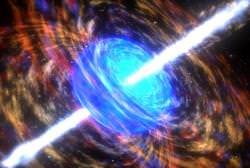When a gamma ray burst detonates, it releases more energy in just a few minutes than our Sun does in its entire lifetime. For a brief time, a gamma ray burst outshines its entire host galaxy. And now NASA’s Swift satellite has found evidence that some bursts can remain active for minutes, or even hours.
Gamma ray bursts are now believed to be a special kind of supernova, where the core of a massive star collapses into a black hole or neutron star. Inrushing gas forms a disk around the central core, and magnetic fields channel material into twin jets emanating from the black hole at nearly light speed.
Early observations by NASA’s Swift satellite found that gamma ray bursts are often followed minutes or hours later by short-lived X-ray flares. These flares suggested that the object that created the gamma ray burst is still active, after that initial flash. Instead of consuming all the material in a single burst of energy, there seem to be ongoing waves of material falling into the black hole. With each wave of consumption, the black hole gives off a torrent of X-ray radiation until everything is gone.
Original Source: NASA News Release

